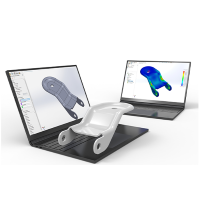Technical Blogs

CATIA V5: Why Is This The Best CAD Software For Designers?
Are you looking for the best CAD software to help you with your design projects? CATIA V5 might be just what you need. This powerful software has a range of features that make it ideal for everything from 3D modeling to creating complex assemblies.
16 Jun 2024

Octave Code for Creating GIF Animation Files: A Step-by-Step Tutorial
Octave Code is one of the most popular open-source problem solvers in the mechanical industry. While it lacks the convenience, efficiency, and premium features like the WriteVideo Functionality in MATLAB, Octave Code is still a fully functional and open-sourced tool that any engineer can use.
09 Aug 2023

Multibody Dynamics: A Solidworks FAQ
Fps denotes frames per second; let's explain this with a small calculation with the internal Geneva mechanism. Let’s assume you are giving motor input to the driver wheel as 10rpm and simulating for 6 seconds. If you give 60 fps, what does it mean?
12 Jul 2023

SLDD: The Key to Reusable Simulink Models
Simulink Data Dictionary is a signal & data maintaining repository where the signals & calibration data maintained in the form of m-script or loaded into the base workspace can be brought together under a single repository.
11 Jul 2023

How to Avoid Cut Extrude Disasters in Your Superstructures
Cut extrude is a powerful tool in CAD software, but it can also be a source of problems. If not used correctly, cut extrude can cause serious issues in superstructures.
10 Jul 2023

How to Save Your SolidWorks Models in a Parasolid Format
Parasolid files are 3D geometric modeling components that are selected by leading vendors and many end-user organizations. It can be utilized for many different applications and can be operated in CAD software including Solidworks.
09 Jul 2023

How Ode45 Takes the Pain Out of Solving Higher Order Derivatives
ODE45 is a standard MATLAB solver used to solve first-order ordinary differential equations. The function ODE45 implements a Runge-Kutta method with a variable time step for its computation.
06 Jul 2023

How to Write a Flowchart That Will Make Your Algorithm Sing
In branch control, there is a condition and according to a condition, a decision of either TRUE or FALSE is achieved. In the case of TRUE, one of the two branches is explored; but in the case of the FALSE condition, the other alternative is taken.
05 Jul 2023

CFD: How to Deal with Errors and Uncertainties
In order to develop trust and confidence in CFD simulations, one needs to understand at best, to evaluate and control the errors and uncertainty associated with CFD simulations.
04 Jul 2023

Basic Understanding of Design Automation
Design automation refers to the use of computer software and tools to assist in the design and development of physical or digital products. This can include everything from the initial concept and prototyping stages to the final production and manufacturing processes.
03 Jul 2023

Stateflow: A Visual Programming Language for Embedded Systems
Control logic is a paramount part of a software program that controls the operations of the program. The control logic answers to commands from the user, and it also acts on its own to execute automated tasks that have been structured into the program.
02 Jul 2023

Under Relaxation Factors: How to Get the Most Out of Your CFD Simulations
CFD Simulations are carried out based on Navier Stoke equations. I.e continuity equation, momentum equation and energy equations.
29 Jun 2023
